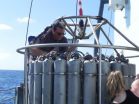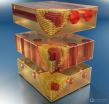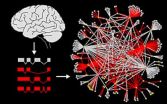(Press-News.org) Fresh insights into the processes that control brain cell production could pave the way for treatments for brain cancer and other brain-related disorders.
Scientists have gained new understanding of the role played by a key molecule that controls how and when nerve and brain cells are formed – a process that allows the brain to develop and keeps it healthy. Their findings could help explain what happens when cell production goes out of control, which is a fundamental characteristic of many diseases including cancer.
Researchers have focused on a RNA molecule, known as miR-9, which is linked to the development of brain cells, known as neurons and glial cells. They have shown that a protein called Lin28a regulates the production of miR-9, which in turn controls the genes involved in brain cell development and function.
Scientists carried out lab studies of embryonic cells, which can develop into neurons, to determine how Lin28a controls the amount of miR-9 that is produced.
They found that in embryonic cells, Lin28a prevents production of miR-9 by triggering the degradation of its precursor molecule. In developed brain cells, Lin28a is no longer produced, which enables miR-9 to accumulate and function. In cancer cells, Lin28a production is re-established, and as a result this natural process is disrupted.
Researchers used a series of lab tests to unravel the complex processes that are directed by the Lin28a protein. They say further studies could help explain fully the role of Lin28a and miR-9 in brain development, and pave the way to the development of novel therapies.
Dr Gracjan Michlewski of the School of Biological Sciences, who led the study, said: "Understanding more of the complex science behind the fundamental processes of cell development will helps us learn more about what happens when this goes wrong – and what might be done to prevent it."
INFORMATION:
The study, published in Nature Communications, was supported by the Wellcome Trust and the Medical Research Council.
Brain cell discovery could open doors to targeted cancer therapies
2014-04-11
ELSE PRESS RELEASES FROM THIS DATE:
How nerve cells flexibly adapt to acoustic signals
2014-04-11
Researchers at Ludwig-Maximilians-Universitaet (LMU) in Munich have shown how nerve cells flexibly adapt to acoustic signals: Depending on the input signal, neurons generate action potentials either near or far away from the cell body. This flexibility improves our ability to localize sound sources.
In order to process acoustic information with high temporal fidelity, nerve cells may flexibly adapt their mode of operation according to the situation. At low input frequencies, they generate most outgoing action potentials close to the cell body. Following inhibitory or ...
Study resolves controversy over nitrogen's ocean 'exit strategies'
2014-04-11
A decades-long debate over how nitrogen is removed from the ocean may now be settled by new findings from researchers at Princeton University and their collaborators at the University of Washington.
The debate centers on how nitrogen — one of the most important food sources for ocean life and a controller of atmospheric carbon dioxide — becomes converted to a form that can exit the ocean and return to the atmosphere where it is reused in the global nitrogen cycle.
Researchers have argued over which of two nitrogen-removal mechanisms, denitrification and anammox, is ...
Forging iron women
2014-04-11
Published in the Journal of Nutrition, researchers undertook a systematic review and analysis of the effect of iron supplementation to the exercise performance of women aged from .
Lead researcher, Dr Sant-Rayn Pasricha from the Melbourne School of Population and Global Health found that iron supplementation improved women's exercise performance, in terms of both the highest level they could achieve at 100% exertion (maximal capacity) and their exercise efficiency at a submaximal exertion. Women who were given iron were able to perform a given exercise using a lower ...
Eye of the beholder -- improving the human-robot connection
2014-04-11
Researchers are programming robots to communicate with people using human-like body language and cues, an important step toward bringing robots into homes.
Researchers at the University of British Columbia enlisted the help of a human-friendly robot named Charlie to study the simple task of handing an object to a person. Past research has shown that people have difficulty figuring out when to reach out and take an object from a robot because robots fail to provide appropriate nonverbal cues.
"We hand things to other people multiple times a day and we do it seamlessly," ...
Greenland ice cores show industrial record of acid rain, success of US Clean Air Act
2014-04-11
The rise and fall of acid rain is a global experiment whose results are preserved in the geologic record.
By analyzing samples from the Greenland ice sheet, University of Washington atmospheric scientists found clear evidence of the U.S. Clean Air Act. They also discovered a link between air acidity and how nitrogen is preserved in layers of snow, according to a paper published this week in the Proceedings of the National Academy of Sciences.
Forty-five years ago, acid rain was killing fish and dissolving stone monuments on the East Coast. Air pollution rose beginning ...
Researchers develop ErSb nanostructures with applications in infrared and terahertz ranges
2014-04-11
In a feat that may provide a promising array of applications, from energy efficiency to telecommunications to enhanced imaging, researchers at UC Santa Barbara have created a compound semiconductor of nearly perfect quality with embedded nanostructures containing ordered lines of atoms that can manipulate light energy in the mid-infrared range. More efficient solar cells, less risky and higher resolution biological imaging, and the ability to transmit massive amounts of data at higher speeds are only a few applications that this unique semiconductor will be able to support.
"This ...
The taming of the shrew
2014-04-11
The Borna disease – named after the German city of Borna, which saw a cluster of cases over 100 years ago – mainly affects horses and sheep, and in rare cases cattle and rabbits too. A single case of an infected dog has been reported. Affected horses seclude themselves from the herd and suffer from depression and general disorientation. Ultimately, this incurable infection is fatal.
Borna virus detected in bicoloured shrews
Researchers have long been in the dark concerning the transmission mechanism of the Borna virus. The bicoloured shrew was one suspect, but definitive ...
Nobel prize candidates wait often over 20 years to win their prize
2014-04-11
Candidates for a Nobel prize often have to wait more than 20 years to receive this highest of scientific accolades. According to a Correspondence by Santo Fortunato of Aalto University in Finland and colleagues, such nail-biting delays are becoming the norm — to the point that aspiring laureates may themselves have expired by the time the medal is due to be presented.
Before 1940, Nobel prizes were awarded more than 20 years after the original discovery for only about 11%, 15% and 24% of physics, chemistry and physiology or medicine prizes, respectively. But by 1985, ...
The ATM strikes back
2014-04-11
Its head and pronotum are usually rusty red, and its abdomen blue or shiny green: the bombardier beetle is approximately one centimetre long and common to Central Europe. At first glance, it appears harmless, but it possesses what is surely the most aggressive chemical defence system in nature. When threatened, the bombardier beetle releases a caustic spray, accompanied by a popping sound. This spray can kill ants or scare off frogs. The beetle produces the explosive agent itself when needed. Two separately stored chemicals are mixed in a reaction chamber in the beetle's ...
Splice variants reveal connections among autism genes
2014-04-11
A team of researchers from the University of California, San Diego School of Medicine and the Center for Cancer Systems Biology (CCSB) at the Dana-Farber Cancer Institute has uncovered a new aspect of autism, revealing that proteins involved in autism interact with many more partners than previously known. These interactions had not been detected earlier because they involve alternatively spliced forms of autism genes found in the brain.
In their study, published in the April 11, 2014 online issue of Nature Communications, the scientists isolated hundreds of new variants ...



